
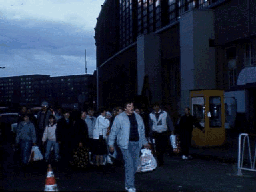
 |  |
East Germans shopping in a well-stocked | Bringing it all back home: Shoppers return |
Currently the Opposition in East Germany is disillusioned. Before the Wall came down, they were united. Now there is fragmentation. They used to have a slogan, " `A Nation is rising!' But it seems that right after they got up, they went shopping - or left town for good. -- Between 1500 and 2000 leave East Germany daily.
East Germans want economic parity with West Germans and they are not going to stop short of that goal. Many East Berliners want reformed socialism. Most East Germans want reunification --right now!
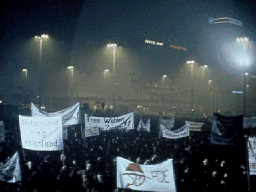
One development as of this past January is that the West German political parties have begun to pour in money into East Germany,giving them office equipment, copiers, fax machines, and renting office space. These parties are trying to win voters in the March 19th election, and beyond - in a unified Germany. The old reborn East German SPD, with help from party stalwarts like Willy Brandt from the West, may emerge victorious in East Germany's upcoming March 18 election, or the electorate may chose the current conservative party of West Germany, the CDU. I personally hope that the SPD wins big, because my father, an immigrant to the US in the late 'twenties, was SPD, and his father, too. On January 22, the news was that more party members, men with credibility in East Germany, were continuing to resign. Many East Germans, carrying empty suitcases, made a symbolic exodus into West Germany and back the again. A third of the nation has its suitcases packed for real.
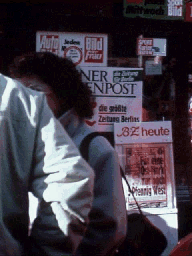
On February 9 there was a report on CNN that there was talk that the West German mark would soon become the official currency in East Germany. No surprise, since it was rapidly becoming that in a defacto way already. The only interesting point will be the ratio. If were less than 1 to 5, it would cause plenty of displacement in the East. The West Germans predict an immanent collapse of the East German economy, which may be only a slight exaggeration. If things were functioning poorly before the Wall opened, now they are coming to a standstill. The East Germans say they will make it to the March 18 elections. This is dubious, with half the people - including the police - walking away from their jobs. People have no confidence in the East Mark. They want clarity about their economic condition, which to them means the West Mark. The West Mark in turn means western-style capitalism and an immediate threat to many pensions, and subsidized items like housing and bread, as the economy faces market-oriented conditions.
 | 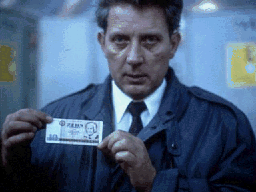 |
| This side depicts a young woman working in a factory. She orders a Trabant car... | He turns the bill. This side shows a white-haired elderly woman...at the age when she finally gets the car! |
A list of East Germany's major problems would be very long. It would have to include:
1. First, a stagnant economy due to inane politically-steered management practices. There are a few industries that might make it by western standards, but most will not withstand competition: they are too old, too wasteful, too inefficient. This problem can be turned around to a degree. Joint ventures with western firms are already underway. But while help may be on the way, as many as three million workers may be laid off as non-competitive industries phase out.
2. Second problem: Pollution. Streams and lakes are heavily polluted,the water is not drinkable, the air unbreathable. There are toxic wastes all over and four poorly run nuclear power plants, one of which, Greifswald, is known as Chernobyl- North. It will take a generation to correct all this to West German standards. A Green movement is starting in East Germany and other East Bloc nations.
3. Third problem: The East German mind-set. No experience with democracy after 56 years of non-democratic rule, (12 of them Nazi)and the legacy of an educational system that stressed intolerance, discipline, and anti-Semitism masked as anti-Zionism.
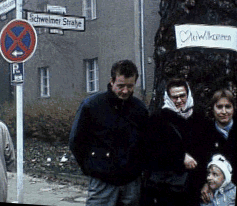
Proceed to 10. The Road to Unification or, switch to another Part:
1. Berlin at the End of WWII--Top of document
2: The First Postwar Decade
3. The Raising of the Wall
4. West Berlin thrives
5. East Berlin, a tourist attraction
6. East Germany during the Wall
7. Bringing down the Wall from within
8. East meets West
9. East German Problems